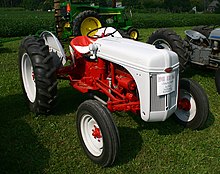Ford N series
The first tractor in the Ford N series was the 9N . It had the first three-point connection for attachments, as it is still used today. This system was called the Ferguson system ; Ferguson later separated from Ford and built under the name Ferguson , later the company was sold to Massey-Harris and continued under Massey Ferguson . The 9N was introduced in Dearborn on June 29, 1939 . It was intended as an all-purpose tractor for smaller farms.
The 9N was revised several times and finally came out as the Model 2N in late 1941 . Major improvements included a larger radiator fan and a closed cooling system. In the Second World War , raw materials had to be saved, and so there were 2N tractors with wheels made entirely of steel and with bare engines. Batteries were needed for the war effort and so the steel-wheeled tractors were only available with magneto ignition . After the war there was a return to rubber-tyred wheels and battery ignition. All 9N and 2N had a front manifold that was difficult to maintain.
Official production of the 8N began in 1947. The main difference between the 8N and its predecessors was the four-speed transmission, which replaced the previous three-speed transmission. The 8N had running boards; its hood was painted gray and its body red. The models 9N and 2N were very dark gray and had steps instead of running boards. A rare version of the 8N was the model for the US Air Force with a side-controlled six-cylinder engine. In 1950 the 8N got a side-mounted distributor that was easier to maintain. In 1952, the last year of production, the 8N got eight wheel bolts on the rear wheels instead of the previous six and better brakes.
The 8N was the first model to have a clutch on the left and independent brakes on the right. One of the disadvantages of the 9N, 2N, and 8N was the lack of a hydraulic lifting system. In order to lift an attachment, the PTO shaft had to be running. This approach made difficulties when z. B. a mower should be lifted because the PTO shaft had to run to drive the hydraulic pump on the device. The following year, 1953, Ford brought out the first overhead engine in the Golden Jubilee . Also known as the NAA Ford , this tractor was larger than the 8N and had a hydraulic lifting system.
See also
Web links
swell
- N-series tractors ( Memento from March 1, 2010 in the Internet Archive )
